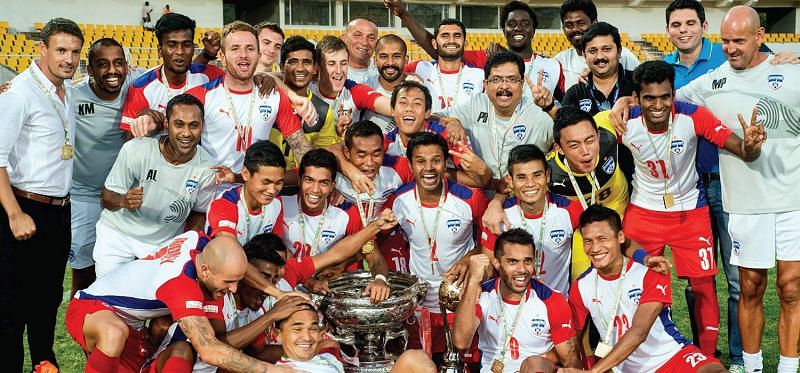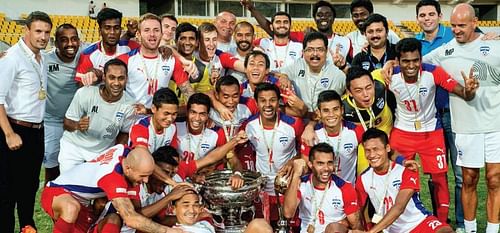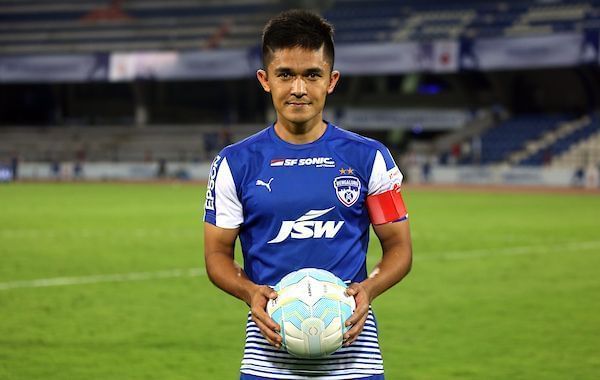
Bangalore Offers Indian Football a New Lease of Life through Bengaluru FC

(Disclaimer: The views expressed are of the writer and do not reflect those of the website)
It was a breezy evening in Bengaluru, then still Bangalore, in September 2013. The air held a heady mixture of eager nervousness coupled with satiated pride, with just a dash of long-awaited relief.
Hordes of football fans of all ages and from all walks of life converged to an erstwhile desolate structure in the heart of the city, the Bangalore Football Stadium. The stage was set for the launch of what would go on to be the most successful Indian football club after the turn of the century, Bengaluru Football Club, against arguably the most successful Indian Club ever, Mohun Bagan.
Fast forward seven months. Bengaluru FC, or BFC for short, was set to play one of the former powerhouses of Indian football, Dempo FC, at the Fatorda Stadium, Goa. Incredibly, the interim period had seen BFC light up the I-League with some dazzling performances against far more established clubs, and by the time of the penultimate match of the season, the fledgeling club was sitting pretty atop the league table, with a draw enough to secure top spot and a first League Title.
Playing with a distinct style, BFC defeated Dempo 4-2 and became the first Indian club to win the country’s top league in their debut season. The next season, they narrowly lost out on the title on the last day to Mohun Bagan, finishing a respectable second.
The following season, 2015-16, saw BFC conquer all the fronts, winning their second I-league title and picking up the Federation Cup along the way too.
However, reaching the final of the AFC Cup in 2016 has been their biggest achievement. They were the first Indian side to do so. Although they lost the match that day against a far superior team, the Air Force Club of Iraq, their performance left an indelible mark in Asian Club Competitions and served as the new standard for all Indian clubs to emulate.
The meteoric rise of the club from Bengaluru not only took their opponents by surprise but exceeded all expectations from their own fans as well. We’ll never know how many times the club captain Sunil Chhetri or former manager Ashley Westwood had to pinch themselves over the course of the season to make sure they weren’t dreaming.
While the Bengalis and Goans from the opposite coastlines of India were still reeling from the blue storm that decimated the traditional hierarchy in the Indian football scene, the AIFF were smugly patting themselves on the back. After all, it was their initiative to offer corporate entities to launch new teams to fill two spots in the I-League that led to the birth of Bengaluru FC.
But one wonders what a new club with zero experience did differently that enabled them to topple the established powers in such a short span of time. Not much in the traditional sense, according to BFC’s manager from the initial years, Ashley Westwood.
According to the former Manchester United trainee, the technical skill of Indian players was at par with those in leagues abroad, but their fitness was what held them back.
For the first time in Indian football, a dedicated nutritionist was employed to dish out customised diet plans to the players. Fitness analysts monitored the players’ vitals during different phases of the game to enable the manager to formulate his tactics according to his team.

As Ashley Westwood stated on more than one occasion, he wasn’t trying to teach his team to play, he was just going about creating the right facilities and the right environment to let his team play to their full potential.
It is no wonder that a team made up of a few rejects (with the exception of the talismanic captain Sunil Chhetri) won the league in two of their first three attempts.
Off the pitch, BFC had another major factor that affected the team performances - the fans. The vociferous BFC fans, termed the West Block Blues, created the kind of atmosphere in the stadium that must give all professional footballers goosebumps.
With the home attendance averaging close to 8,000 over the first season, and even more in subsequent campaigns, the West Block Blues always made their presence felt, whether it be songs in praise of their favourite players or heckling opposition players and managers.
Despite the relatively small size, the Bangalore Football Stadium soon turned into a fortress for the home team, and a daunting venue for rivals to ply their trade. The fans also charted new territory by being one of the first travelling supporters in the country, sometimes outnumbering the home support as well.
Thankfully, a lot more has changed in Indian football since that breezy September evening in Bengaluru. The launch of the Indian Super League in 2014 ushered in a new era where popular celebrities endorsed teams and the fanfare around it caused a lot of heads to turn.
Although the first 2-3 seasons saw insipid football played by former greats well past their prime, the recent seasons have seen a tremendous improvement in quality. Young Indian footballers are getting the opportunity to rub shoulders with talented players from across the world, and the increase in spectators both at the stadiums and in front of television sets across the country can only be a good sign for football in the country.
The recognition received from the AFC ensured the top team in the ISL gets the opportunity to participate in the AFC Cup at the qualifying stage, leading to Bengaluru FC shifting to the new league and leaving teams like Mohun Bagan and East Bengal mulling their options.
With the directions in which the two leagues are headed, it won’t be long before these clubs, along with others, make the shift.
The improving image of Indian football and tireless efforts of the AIFF were further rewarded by FIFA when it was announced that India would host the 2017 FIFA U-17 World Cup. Apart from the prestige of hosting such a major event, the big bonus came in the form of automatic qualification for the India U-17 team, being the hosts.
Although the boys in blue lost all their three group stage matches, their performances filled the nation with pride and the younger generation with a hunger to achieve even more. The Indian colts have given a good account of themselves at various international tournaments since then and have managed to defeat traditional giants like Argentina, Iran and Serbia.
Watching the ISL today, I often go down memory lane to a time before all this had happened. A time when Indian football had reached its nadir and was shackled with mediocrity. A time when the national team’s ranking was in a free-fall, as was much of the country’s interest in the domestic league.
As young football fans watching the English Premier League at a sports bar in Bengaluru, all we wished for was a team closer to home that we could support with all our passion. In Bengaluru FC, we found just that.
Back then, we used to silently hope and pray that one day we might see India play in the FIFA World Cup; today, there is a burgeoning belief that we will see India play in the FIFA World Cup.
Indian football may be in its adolescence, but it was born on that breezy September evening in Bengaluru.